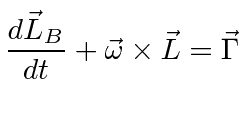Next: Example: Symmetric Top with Up: Dynamics of Rigid Bodies Previous: Body Frame Coordinates Contents
It is simple to derive a set of equations describing the motion of a rotating object in the rotating (Body) frame. If an external torque is applied, it may be difficult to work in the body system so this will most often be useful for problems with no torque.
In the Inertial system, we have


 |
||
 |
||
 |
||
 |
||
 |
 |
 does not imply
a sum over
does not imply
a sum over